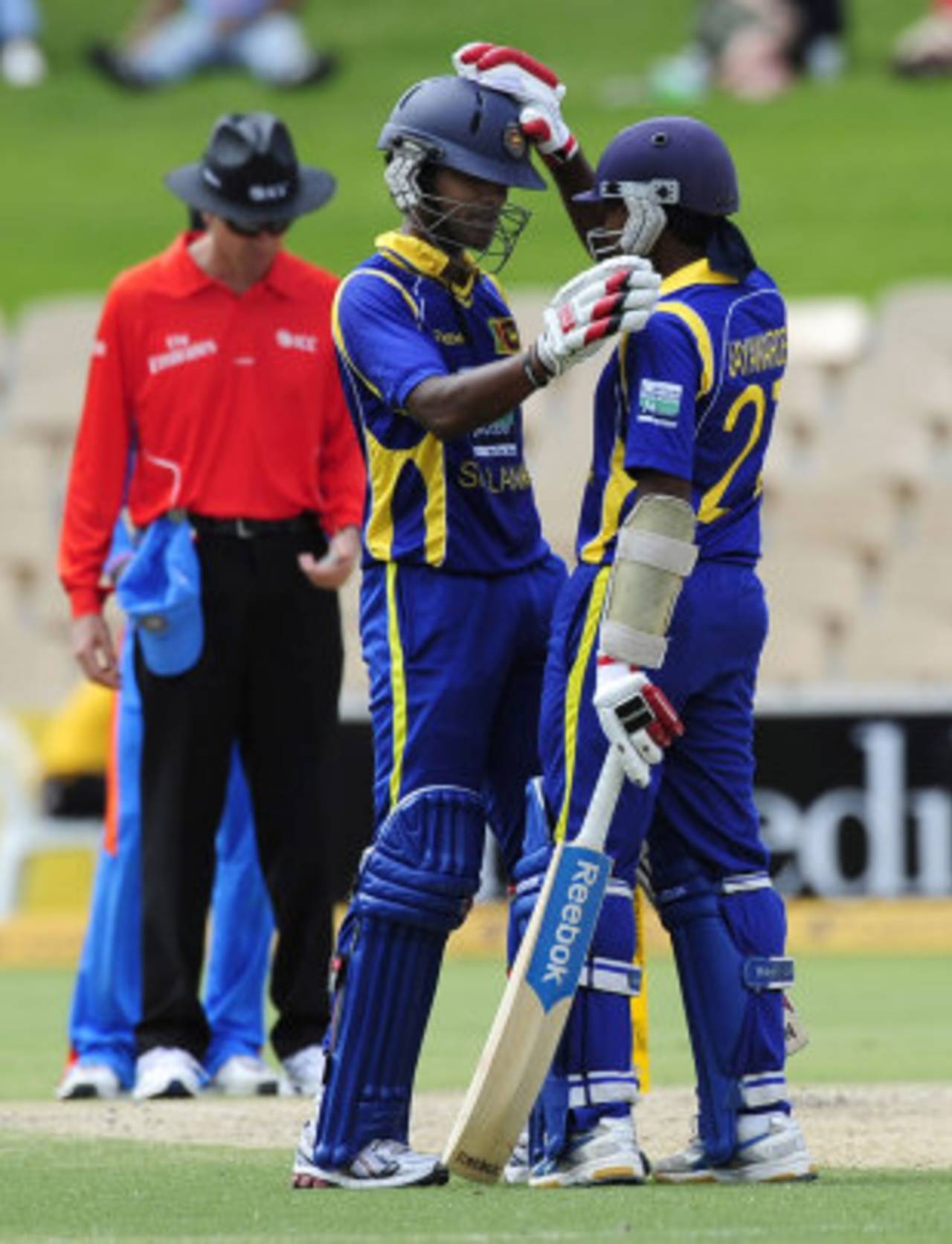The captain Sri Lanka have needed
Mahela Jayawardene has turned Sri Lanka's performance around in a matter of a month. The young players he backed have rewarded his faith in this tri-series
Andrew Fernando
03-Mar-2012

Dinesh Chandimal has flourished under Jayawardene • Associated Press
"Every country needs to have the best captain, and the best captain in Sri Lanka is Mahela Jayawardene, and I think everybody knows that," Geoff Marsh said at the end of his brief stint as head coach.
In March 2009, Jayawardene's first captaincy stint hit an abrupt blockade, figuratively and literally, when Sri Lanka's bus came under attack in Lahore. Three years of a different sort of tumult later, he is back at the helm. As the nine-run win in Melbourne and Sri Lanka's progression to the triangular series final proved, it's a job he should never have left.
Severely crippled by the loss of two major links in the bowling attack (who also happen to be two of the side's best fielders), Sri Lanka's defence of 238, on a surface that offered little for the pacemen and even less for spinners, was nothing short of a heist. Jayawardene didn't simply limit damage when he turned to part-timers who hadn't bowled through the entire competition - and in Lahiru Thirimanne's case, never before in ODIs. Stacked ring fields conveyed a clear mandate to the makeshift attack, allowed even the most pedestrian operator to become a wicket-taking threat.
Jayawardene's efficient use of Lasith Malinga was perhaps the captaincy highlight in an innings dripping with the stuff. Resisting the temptation to bring Malinga on to halt Shane Watson's ominous association with Michael Hussey, he waited until the ball was older before probing for that heavy blow. In the second over of his second spell, Malinga produced a tailing yorker as unplayable as any in the match, to uproot Watson's middle stump. Had he been introduced earlier and the reverse swing been less pronounced, Watson, batting on a half-century, may well have dug it out.
Throughout the evening, the field placings were bold and the mood impeccable. A leg gully - a startling rarity in Tests, let alone limited-overs cricket - shut down the leg side for David Hussey. The in-out fields for James Pattinson and Clint McKay ensured any dents they made into the target would have to be hard-earned and well thought-out. The short, straight cover that ambushed David Warner at the top of the innings, was an almost forgotten piece of trickery after the thrill of the finish.
All this too, following that crushing loss to India in Hobart. Losing after having made 320 is disheartening enough, but the manner in which Sri Lanka were mauled made for one of the most deflating losses in recent memory. Jayawardene himself admitted it had taken 24 hours to move on. But three nights after the Bellerive horror, Sri Lanka delivered their most tenacious defensive effort in the tournament. Jayawardene's ability to haul a young attack out of its funk and prepare it for a virtual final is almost as impressive as his craft on the occasion.
The emphasis on youngsters, and their subsequent success, is a Jayawardene hallmark. In 2006, he kept faith in Chamara Silva after the batsman collected a Test pair on debut, even as critics in Sri Lanka clamoured for a more experienced batsman to take his spot. Silva made 61 and 152 not out in the next match to ensure a series-levelling win. Upul Tharanga was under similar scrutiny during the 2007 World Cup before going on to score 73 from 74 in the World Cup semi-final and contribute heavily to the campaign in the subcontinent four years later.
After years of being two ODI batsmen short of a formidable middle order, in 22-year-olds Dinesh Chandimal and Lahiru Thirimanne, Sri Lanka finally have players who can ease the pressure on the three big top-order bats.
Thisara Perera, too, has made the second allrounder's spot his own. That Chandimal and Perera have finished near the top of the tournament run-getters' and wicket-takers' lists respectively is testament, in part, to their talent, but also to Jayawardene's gentle hand that has coaxed the best out of them.
After nine months of woeful collapses, listless long spells in the field and off-field drama to rival Pakistan, Sri Lanka are again looking like the side who battled to two consecutive World Cup finals, and were once within (however undeservingly) a game of the top Test spot. Under Jayawardene, the side is focused and hungry again. Even without Muttiah Muralitharan, the bowling has rediscovered a penetrative edge and the batsmen are constructing innings as a group. And as ten run-outs in eight matches show, the fielding has been on par with Australia's. A side that couldn't muster competence in any discipline in Paarl seven weeks ago is now excelling in all three. The speed of transformation under the new leader has been mind-boggling.
Kumar Sangakkara made an admirable attempt at navigating the unique challenges the Sri Lankan captaincy presents, but a limited tolerance for those who did not operate to the same high standards he set for himself shortened the span of his captaincy, while his reliance on intellect over nous limited the effectiveness of his leadership. Under Jayawardene, Sri Lanka have resumed the aggressive, unrestrained, mirthful style that once characterised their cricket. In fact, with him at the top of the innings, the 1996 blueprint that bred the Sri Lankan brand of cricket seems reborn. With a keen finger on the pulse of an innings, a fine temperament and a desire to build for the future, Jayawardene has all the makings of a great captain. Perhaps he already is one.
Andrew Fernando writes for The Pigeon and has a column here